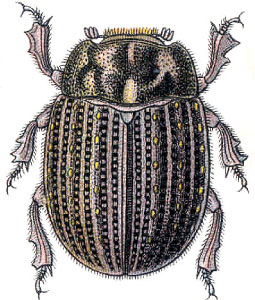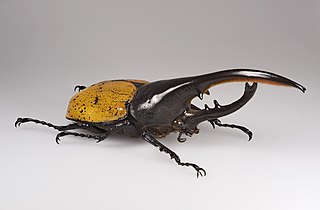
Beetles are insects that form the order Coleoptera, in the superorder Endopterygota. Their front pair of wings are hardened into wing-cases, elytra, distinguishing them from most other insects. The Coleoptera, with about 400,000 described species, is the largest of all orders, constituting almost 40% of described insects and 25% of all known animal life-forms; new species are discovered frequently, with estimates suggesting that there are between 0.9 to 2.1 million total species. Found in almost every habitat except the sea and the polar regions, they interact with their ecosystems in several ways: beetles often feed on plants and fungi, break down animal and plant debris, and eat other invertebrates. Some species are serious agricultural pests, such as the Colorado potato beetle, while others such as Coccinellidae eat aphids, scale insects, thrips, and other plant-sucking insects that damage crops.

Passalidae is a family of beetles known variously as "bessbugs", "bess beetles", "betsy beetles" or "horned passalus beetles". Nearly all of the 500-odd species are tropical; species found in North America are notable for their size, ranging from 20–43 mm, for having a single "horn" on the head, and for a form of social behavior unusual among beetles.

Amphizoa is a genus of aquatic beetles in the suborder Adephaga, placed in its own monogeneric family, Amphizoidae. There are five known species of Amphizoa, three in western North America and two in eastern palearctic. They are sometimes referred to by the common name troutstream beetles.

Trogidae, sometimes called hide beetles, is a family of beetles with a distinctive warty or bumpy appearance. Found worldwide, the family includes about 300 species contained in four or five genera.

Dermestidae are a family of Coleoptera that are commonly referred to as skin beetles. Other common names include larder beetle, hide or leather beetles, carpet beetles, and khapra beetles. There are approximately 500 to 700 species worldwide. They can range in size from 1 to 12 mm. Key characteristics for adults are round oval shaped bodies covered in scales or setae. The usually clubbed antennae fit into deep grooves. The hind femora also fit into recesses of the coxa. Larvae are scarabaeiform and also have setae.

The Hercules beetle is a species of rhinoceros beetle native to the rainforests of Central America, South America, and the Lesser Antilles. It is the longest extant species of beetle in the world, and is also one of the largest flying insects in the world.

Trox is a genus of hide beetle in the subfamily Troginae.

Acanthacaris is a genus of deep-water lobsters. It contains two species, A. caeca and A. tenuimana, and is the only genus in the subfamily Neophoberinae.

Trox scaber is a beetle of the family Trogidae. The 5 to 8 mm long insect is found worldwide, including in Europe, and lives in bird nests.

Cheilomenes is a genus of ladybirds (Coccinellidae). Like other members of their subfamily they are large typical ladybirds. They are always shiny and often have bright spots on the elytra. The common African species C. lunata is an important predator of the citrus aphid, Toxoptera, and wheat aphid, while C. vicina has been suggested as a biological control agent for the cowpea aphid. Both the larvae and adults are predatory. Freshly emerged larvae consume unhatched eggs, and eventually have a dappled appearance and 6 tubercles on each abdominal segment. Vulnerable stages in the life of C. sexmaculata, including oviposition, hatching, moulting and pupation have been shown to occur after dark, probably as an adaptation to avoid exposure to natural enemies.

Ips is a genus of beetles in the family Curculionidae, the true weevils. They are bark beetles, members of the subfamily Scolytinae. Species are distributed throughout the Northern Hemisphere. Some are known as introduced species in Australia and Africa. Many species are pests of forest trees, especially pines and spruces. They are known commonly as engraver beetles, ips engraver beetles, and pine engravers.

Bodiloides ictericus is a species of dung beetle in the family Scarabaeidae, found in the Palearctic. It is one of more than 50 species in the genus Bodiloides.
Coelostoma (Holocoelostoma) stultum, is a species of water scavenger beetle widely distributed in Palearctic and Oriental realms from West Pacific towards Indian Ocean, such as China, Taiwan, Andaman Islands, Myanmar, India, Indonesia, Japan, Korea, Malaysia, Mascarene Islands, Nicobar Islands, Oman, Philippines, Saudi Arabia, South Korea, Sri Lanka, Thailand, United Arab Emirates, Oman, and Vietnam.
Phaeochrous compactus, is a species of scavenger scarab beetle endemic to Sri Lanka.
Phoberus is a genus of hide beetle in the subfamily Troginae. It was initially a subgenus of Trox before taxonomists reorganized it into its own genus. The genus is monophyletic, with all species evolved from a single common ancestor. Most beetle species in the genus live in Africa.
Phoberus cyrtus is a species of hide beetle in the subfamily Troginae discovered by Erwin Haaf in 1953.
Phoberus sternbergi is a species of hide beetle in the subfamily Troginae discovered by the scientists van de Merwe and Scholtz in 2005. Like with many other beetle species, P. sternbergi has not been observed again after its discovery, so all knowledge of the species comes from the 8 individual beetles van de Merwe and Scholtz saw during fieldwork.
Phoberus ngomensis is a species of hide beetle in the subfamily Troginae discovered by the scientists van de Merwe and Scholtz in 2005. Like with many other beetle species, P. ngomensis has not been observed again after its discovery, so all knowledge of the species comes from the 166 individual beetles van de Merwe and Scholtz saw during fieldwork.
Phoberus fumarius is a species of hide beetle in the subfamily Troginae discovered by Erwin Haaf in 1953.
Phoberus disjunctus is a species of hide beetle in the subfamily Troginae discovered by coleopterologist Werner P. Strümpher in 2016.











